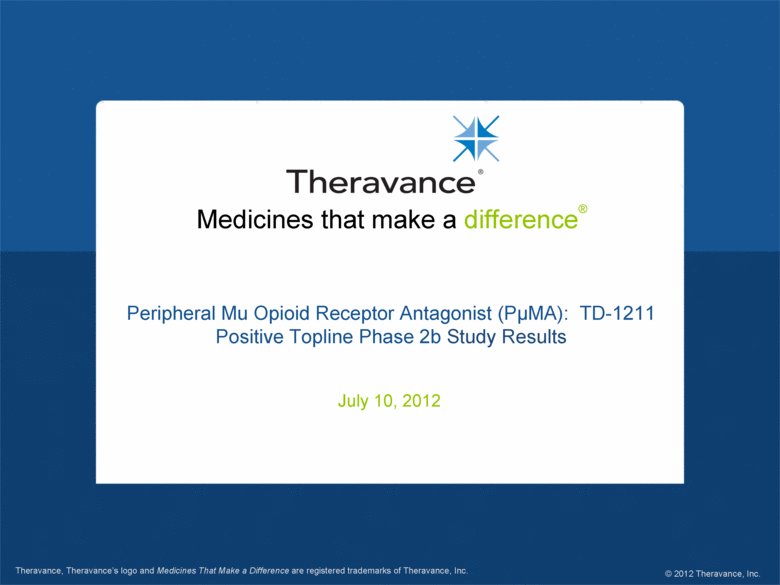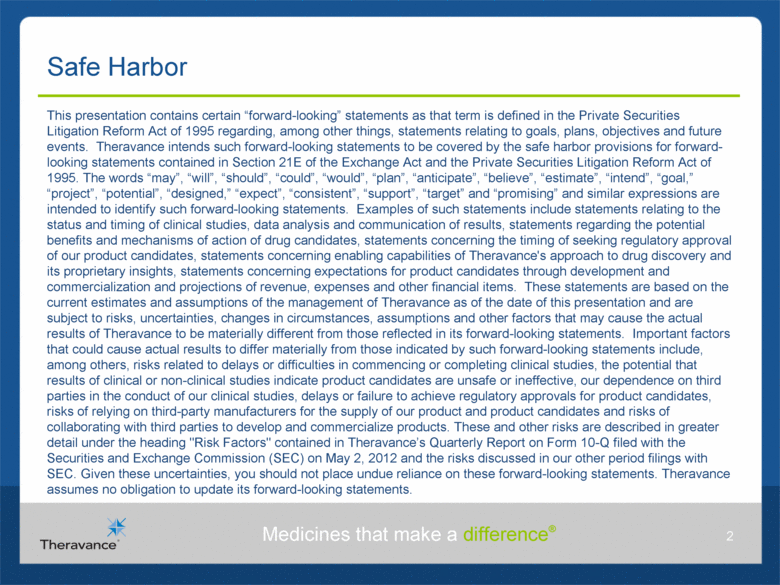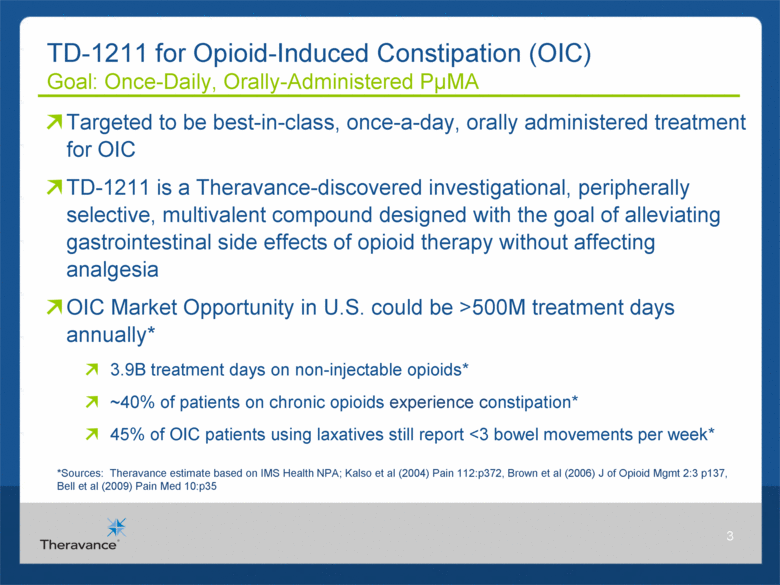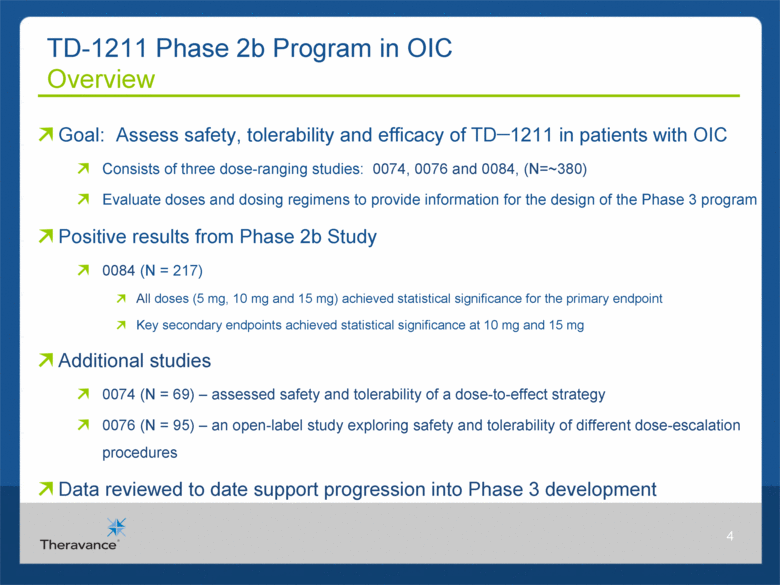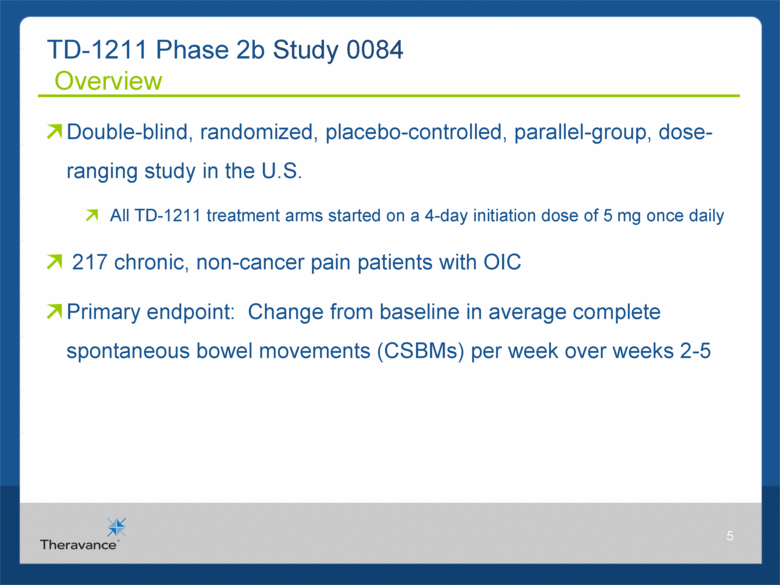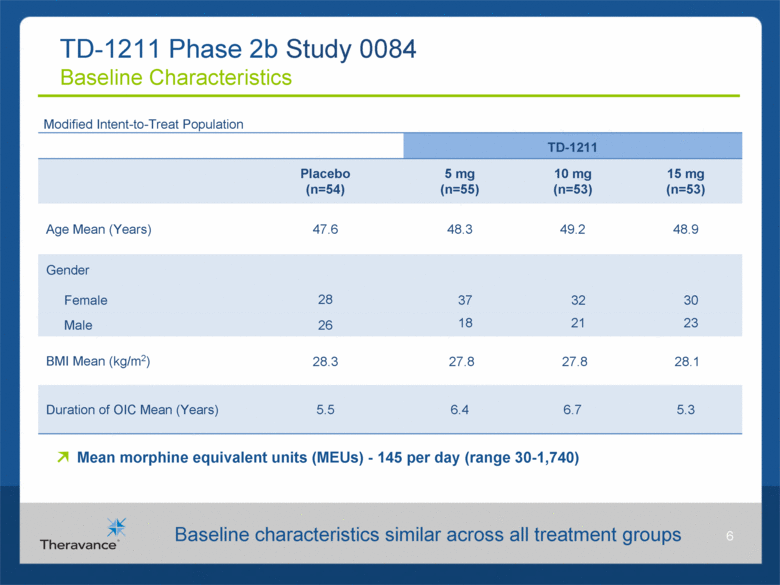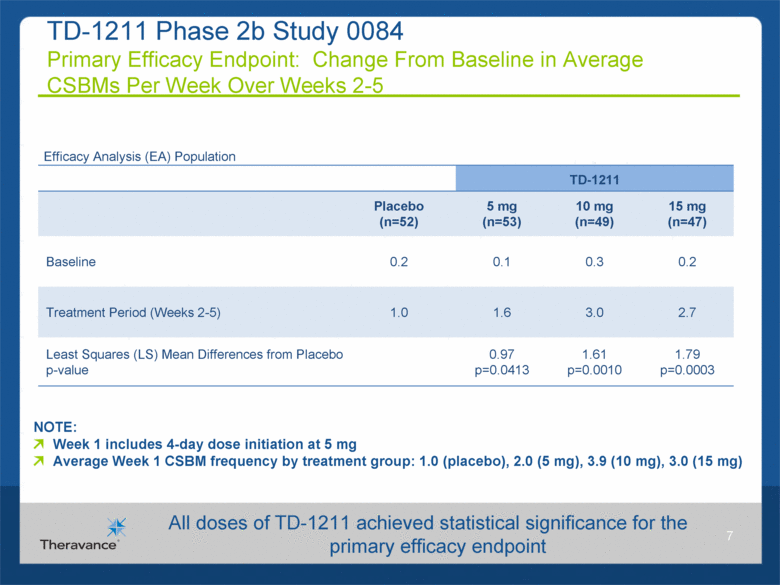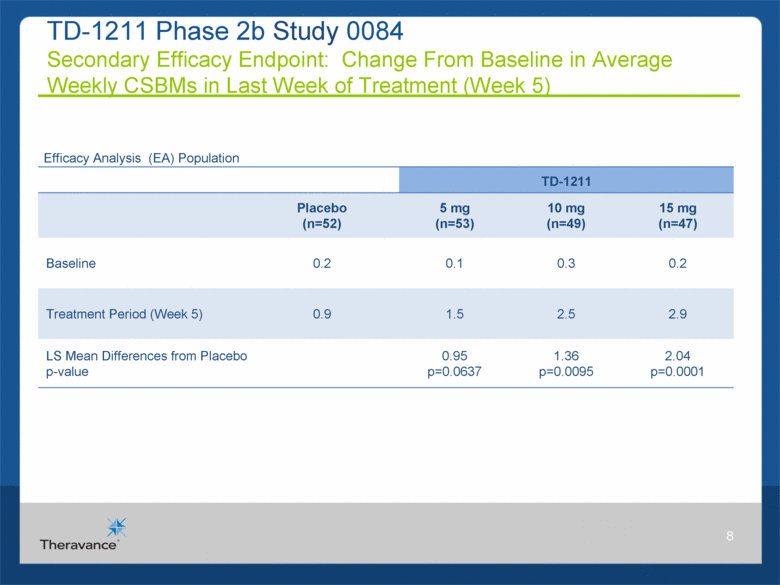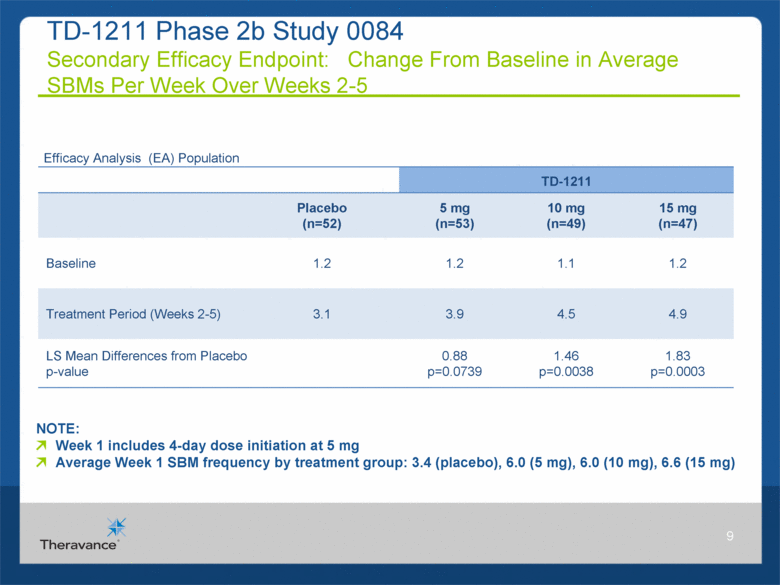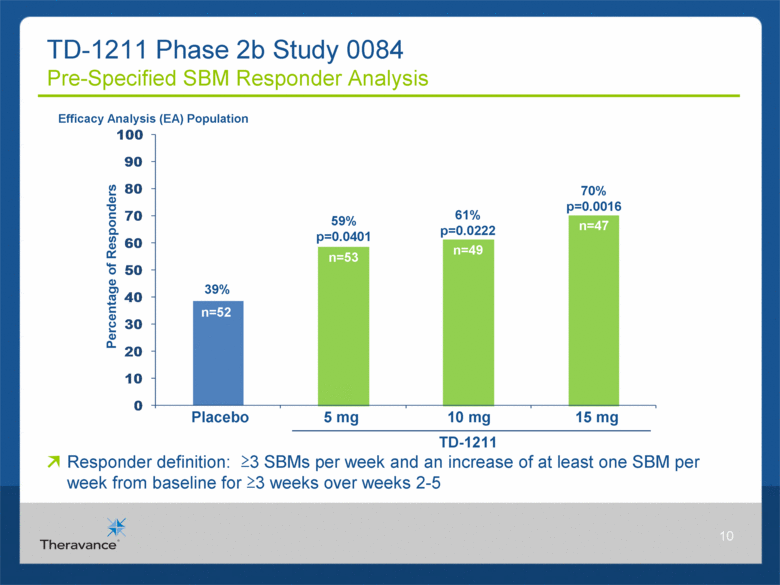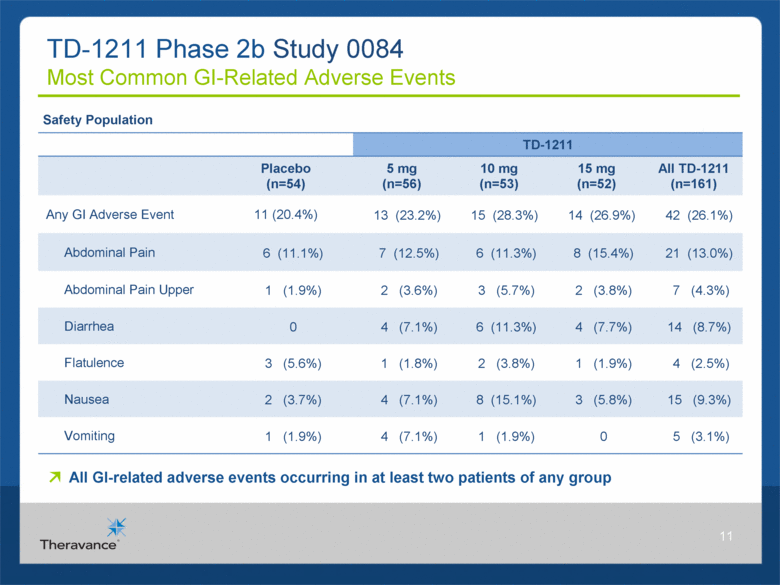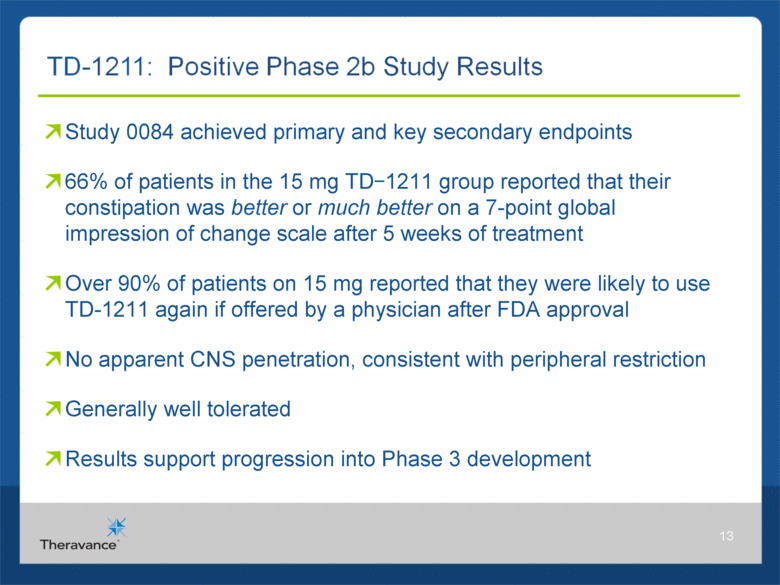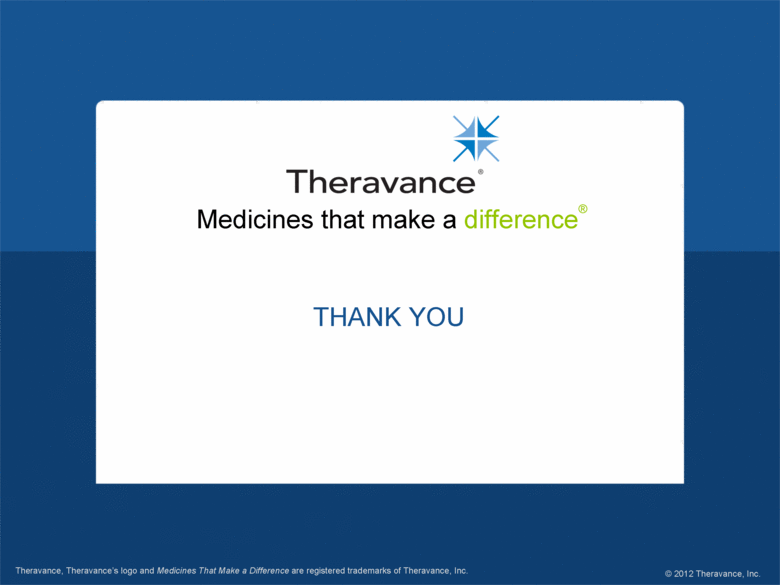Attached files
| file | filename |
|---|---|
| 8-K - 8-K - Innoviva, Inc. | a12-15745_18k.htm |
| EX-99.1 - EX-99.1 - Innoviva, Inc. | a12-15745_1ex99d1.htm |
Exhibit 99.2
|
|
July 10, 2012 Peripheral Mu Opioid Receptor Antagonist (PµMA): TD-1211 Positive Topline Phase 2b Study Results Theravance, Theravance’s logo and Medicines That Make a Difference are registered trademarks of Theravance, Inc. © 2012 Theravance, Inc. |
|
|
Safe Harbor This presentation contains certain “forward-looking” statements as that term is defined in the Private Securities Litigation Reform Act of 1995 regarding, among other things, statements relating to goals, plans, objectives and future events. Theravance intends such forward-looking statements to be covered by the safe harbor provisions for forward-looking statements contained in Section 21E of the Exchange Act and the Private Securities Litigation Reform Act of 1995. The words “may”, “will”, “should”, “could”, “would”, “plan”, “anticipate”, “believe”, “estimate”, “intend”, “goal,” “project”, “potential”, “designed,” “expect”, “consistent”, “support”, “target” and “promising” and similar expressions are intended to identify such forward-looking statements. Examples of such statements include statements relating to the status and timing of clinical studies, data analysis and communication of results, statements regarding the potential benefits and mechanisms of action of drug candidates, statements concerning the timing of seeking regulatory approval of our product candidates, statements concerning enabling capabilities of Theravance's approach to drug discovery and its proprietary insights, statements concerning expectations for product candidates through development and commercialization and projections of revenue, expenses and other financial items. These statements are based on the current estimates and assumptions of the management of Theravance as of the date of this presentation and are subject to risks, uncertainties, changes in circumstances, assumptions and other factors that may cause the actual results of Theravance to be materially different from those reflected in its forward-looking statements. Important factors that could cause actual results to differ materially from those indicated by such forward-looking statements include, among others, risks related to delays or difficulties in commencing or completing clinical studies, the potential that results of clinical or non-clinical studies indicate product candidates are unsafe or ineffective, our dependence on third parties in the conduct of our clinical studies, delays or failure to achieve regulatory approvals for product candidates, risks of relying on third-party manufacturers for the supply of our product and product candidates and risks of collaborating with third parties to develop and commercialize products. These and other risks are described in greater detail under the heading "Risk Factors" contained in Theravance’s Quarterly Report on Form 10-Q filed with the Securities and Exchange Commission (SEC) on May 2, 2012 and the risks discussed in our other period filings with SEC. Given these uncertainties, you should not place undue reliance on these forward-looking statements. Theravance assumes no obligation to update its forward-looking statements. 2 Medicines that make a difference® |
|
|
TD-1211 for Opioid-Induced Constipation (OIC) Goal: Once-Daily, Orally-Administered PµMA Targeted to be best-in-class, once-a-day, orally administered treatment for OIC TD-1211 is a Theravance-discovered investigational, peripherally selective, multivalent compound designed with the goal of alleviating gastrointestinal side effects of opioid therapy without affecting analgesia OIC Market Opportunity in U.S. could be >500M treatment days annually* 3.9B treatment days on non-injectable opioids* ~40% of patients on chronic opioids experience constipation* 45% of OIC patients using laxatives still report <3 bowel movements per week* 3 *Sources: Theravance estimate based on IMS Health NPA; Kalso et al (2004) Pain 112:p372, Brown et al (2006) J of Opioid Mgmt 2:3 p137, Bell et al (2009) Pain Med 10:p35 |
|
|
TD-1211 Phase 2b Program in OIC Overview Goal: Assess safety, tolerability and efficacy of TD-1211 in patients with OIC Consists of three dose-ranging studies: 0074, 0076 and 0084, (N=~380) Evaluate doses and dosing regimens to provide information for the design of the Phase 3 program Positive results from Phase 2b Study 0084 (N = 217) All doses (5 mg, 10 mg and 15 mg) achieved statistical significance for the primary endpoint Key secondary endpoints achieved statistical significance at 10 mg and 15 mg Additional studies 0074 (N = 69) – assessed safety and tolerability of a dose-to-effect strategy 0076 (N = 95) – an open-label study exploring safety and tolerability of different dose-escalation procedures Data reviewed to date support progression into Phase 3 development 4 |
|
|
TD-1211 Phase 2b Study 0084 Overview Double-blind, randomized, placebo-controlled, parallel-group, dose-ranging study in the U.S. All TD-1211 treatment arms started on a 4-day initiation dose of 5 mg once daily 217 chronic, non-cancer pain patients with OIC Primary endpoint: Change from baseline in average complete spontaneous bowel movements (CSBMs) per week over weeks 2-5 5 |
|
|
TD-1211 Placebo (n=54) 5 mg (n=55) 10 mg (n=53) 15 mg (n=53) Age Mean (Years) 47.6 48.3 49.2 48.9 Gender Female 28 37 32 30 Male 26 18 21 23 BMI Mean (kg/m2) 28.3 27.8 27.8 28.1 Duration of OIC Mean (Years) 5.5 6.4 6.7 5.3 Mean morphine equivalent units (MEUs) - 145 per day (range 30-1,740) 6 TD-1211 Phase 2b Study 0084 Baseline Characteristics Baseline characteristics similar across all treatment groups Modified Intent-to-Treat Population |
|
|
TD-1211 Placebo (n=52) 5 mg (n=53) 10 mg (n=49) 15 mg (n=47) Baseline 0.2 0.1 0.3 0.2 Treatment Period (Weeks 2-5) 1.0 1.6 3.0 2.7 Least Squares (LS) Mean Differences from Placebo p-value 0.97 p=0.0413 1.61 p=0.0010 1.79 p=0.0003 7 TD-1211 Phase 2b Study 0084 Primary Efficacy Endpoint: Change From Baseline in Average CSBMs Per Week Over Weeks 2-5 Efficacy Analysis (EA) Population All doses of TD-1211 achieved statistical significance for the primary efficacy endpoint NOTE: Week 1 includes 4-day dose initiation at 5 mg Average Week 1 CSBM frequency by treatment group: 1.0 (placebo), 2.0 (5 mg), 3.9 (10 mg), 3.0 (15 mg) |
|
|
8 TD-1211 Phase 2b Study 0084 Secondary Efficacy Endpoint: Change From Baseline in Average Weekly CSBMs in Last Week of Treatment (Week 5) TD-1211 Placebo (n=52) 5 mg (n=53) 10 mg (n=49) 15 mg (n=47) Baseline 0.2 0.1 0.3 0.2 Treatment Period (Week 5) 0.9 1.5 2.5 2.9 LS Mean Differences from Placebo p-value 0.95 p=0.0637 1.36 p=0.0095 2.04 p=0.0001 Efficacy Analysis (EA) Population |
|
|
9 TD-1211 Phase 2b Study 0084 Secondary Efficacy Endpoint: Change From Baseline in Average SBMs Per Week Over Weeks 2-5 TD-1211 Placebo (n=52) 5 mg (n=53) 10 mg (n=49) 15 mg (n=47) Baseline 1.2 1.2 1.1 1.2 Treatment Period (Weeks 2-5) 3.1 3.9 4.5 4.9 LS Mean Differences from Placebo p-value 0.88 p=0.0739 1.46 p=0.0038 1.83 p=0.0003 Efficacy Analysis (EA) Population NOTE: Week 1 includes 4-day dose initiation at 5 mg Average Week 1 SBM frequency by treatment group: 3.4 (placebo), 6.0 (5 mg), 6.0 (10 mg), 6.6 (15 mg) |
|
|
39% 59% p=0.0401 TD-1211 Phase 2b Study 0084 Pre-Specified SBM Responder Analysis Responder definition: >3 SBMs per week and an increase of at least one SBM per week from baseline for >3 weeks over weeks 2-5 10 Efficacy Analysis (EA) Population TD-1211 Percentage of Responders 70% p=0.0016 61% p=0.0222 Placebo 5 mg 10 mg 15 mg n=52 n=53 n=49 n=47 0 10 20 30 40 50 60 70 80 90 100 |
|
|
TD-1211 Placebo (n=54) 5 mg (n=56) 10 mg (n=53) 15 mg (n=52) All TD-1211 (n=161) Any GI Adverse Event 11 (20.4%) 13 (23.2%) 15 (28.3%) 14 (26.9%) 42 (26.1%) Abdominal Pain 6 (11.1%) 7 (12.5%) 6 (11.3%) 8 (15.4%) 21 (13.0%) Abdominal Pain Upper 1 (1.9%) 2 (3.6%) 3 (5.7%) 2 (3.8%) 7 (4.3%) Diarrhea 0 4 (7.1%) 6 (11.3%) 4 (7.7%) 14 (8.7%) Flatulence 3 (5.6%) 1 (1.8%) 2 (3.8%) 1 (1.9%) 4 (2.5%) Nausea 2 (3.7%) 4 (7.1%) 8 (15.1%) 3 (5.8%) 15 (9.3%) Vomiting 1 (1.9%) 4 (7.1%) 1 (1.9%) 0 5 (3.1%) 11 TD-1211 Phase 2b Study 0084 Most Common GI-Related Adverse Events Safety Population All GI-related adverse events occurring in at least two patients of any group |
|
|
TD-1211 Phase 2b Study 0084 Results Safety Summary Generally well tolerated No treatment-related serious adverse events reported A majority of treatment-related gastrointestinal (GI) adverse events were associated with initiation of treatment, resolved within a few days and were mild or moderate No treatment-related findings in quantitative ECG parameters were observed No evidence of CNS opioid withdrawal or analgesia interference No clinically significant changes in laboratory tests, ECGs, or vital signs 12 |
|
|
Study 0084 achieved primary and key secondary endpoints 66% of patients in the 15 mg TD-1211 group reported that their constipation was better or much better on a 7-point global impression of change scale after 5 weeks of treatment Over 90% of patients on 15 mg reported that they were likely to use TD-1211 again if offered by a physician after FDA approval No apparent CNS penetration, consistent with peripheral restriction Generally well tolerated Results support progression into Phase 3 development 13 |
|
|
THANK YOU Theravance, Theravance’s logo and Medicines That Make a Difference are registered trademarks of Theravance, Inc. © 2012 Theravance, Inc. |

